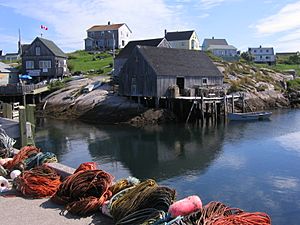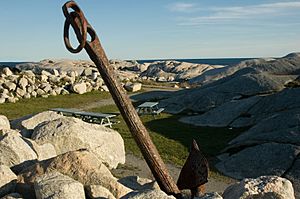Peggy's Cove, Nova Scotia facts for kids
Quick facts for kids
Peggy's Cove
|
|
|---|---|

Peggy's Cove
|
|
| Country | Canada |
| Province | Nova Scotia |
| Administrative district | St. Margarets Bay |
| Founded | 1811 |
| Elevation | 10 m (30 ft) |
| Highest elevation | 15 m (49 ft) |
| Lowest elevation | 0 m (0 ft) |
| Population
(2011)
|
|
| • Total | 30 year-round residents; increases to 35 in summer season |
| Time zone | UTC−4 (ATS) |
| • Summer (DST) | UTC−3 (Atlantic Daylight Saving Time) |
| Area code(s) | 902 & 782 |
| Highways | |
Peggy's Cove is a small, quiet community located on the eastern shore of St. Margarets Bay in Nova Scotia, Canada. It is famous for its beautiful scenery and the historic Peggys Cove Lighthouse, which was built in 1868. This charming village is a popular spot for visitors from all over the world.
Contents
Where is Peggy's Cove Located?
Peggy's Cove is about 43 kilometers (26 miles) southwest of Downtown Halifax. It is one of many small fishing villages found around the Chebucto Peninsula.
The community gets its name from the small bay, or "cove," it sits on. This cove is also next to Peggy's Point. The village marks the eastern edge of St. Margarets Bay.
A Look at Peggy's Cove's Past
The area was first called Eastern Point Harbour or Peggs Harbour in 1766. The village's name likely comes from Saint Margaret's Bay. This bay was named by Samuel de Champlain after his mother, Marguerite Le Roy. "Peggy" is a common nickname for Margaret.
There are also many local stories about how Peggy's Cove got its name. One popular legend says it was named after the only person who survived a shipwreck near the cove. This survivor was a young woman, or in some stories, a little girl. She was adopted by a local family and called Peggy. She later married a local resident in 1800. People started calling her "Peggy of the Cove," and soon the village became known as Peggy's Cove.
How Peggy's Cove Began
The village officially started in 1811. At that time, the Province of Nova Scotia gave over 800 acres of land to six families of German background. These early settlers mostly relied on fishing to make a living. They also farmed in areas where the soil was good and used nearby lands to raise cattle.
In the early 1900s, the population grew to about 300 people. The community had its own schoolhouse, a church, a general store, and even a lobster cannery. Many fishing boats of all sizes could be seen in the cove.
Peggy's Cove Today
Over time, more and more artists and photographers came to Peggy's Cove because of its beauty. As roads improved, the number of tourists also grew. Today, the village has a smaller population, but it is still an active fishing community. It remains a very popular place for tourists to visit.
Dealing with Storms
In 2003, Hurricane Juan caused a lot of damage to roads and homes in Peggy's Cove. The storm also damaged the cove's breakwater, which is a wall built to protect the harbor. Hurricane Bill in 2009 washed away more of the breakwater. This allowed waves to seriously damage a home and a gift shop, and it even washed away one of the village's wooden fish sheds.
In 2021, a new accessible viewing platform was built at Peggy's Cove. This large, safe deck allows visitors to enjoy the views. While people can still walk on the rocks, the platform offers a safer way to experience the area.
Tourism and Local Life
For a long time, fishing was the main way people in Peggy's Cove made money. However, after World War II, tourism started to become more important. Today, Peggy's Cove is a major tourist spot. Even so, many people who live there still fish for lobster. The community has kept its old-fashioned, natural look.
The local government has strict rules about building in Peggy's Cove. This helps to protect its natural beauty and keep property prices fair for people who live there all year.
The historic Carpenter Gothic style St. John's Anglican Church is the only church in Peggy's Cove. It is a special heritage site protected by the municipality.
The first public art gallery, tea-room, and gift shop in Peggy's Cove opened in 1937.
The Rocks of Peggy's Cove
The unique rocks you see at Peggy's Cove were formed over 400 million years ago. During the Devonian Period, hot, melted rock from deep inside the Earth pushed its way up. This created the rocks that are part of the Great Nova Scotia batholith, a large mass of igneous rock.
How Glaciers Shaped the Land
About 20,000 years ago, a huge sheet of ice, called a glacier, moved south from the Arctic. As these glaciers moved and melted, they scraped away large sections of rock, plants, and soil. When the melted ice flowed back to the oceans, the rising sea levels filled the carved-out areas, creating the coves and inlets we see today.
You can also see huge boulders of 415-million-year-old granite scattered across the landscape. These are called glacial erratics. The glaciers picked up these rocks and carried them long distances before dropping them when the ice melted. The movement of the ice and rocks also left scratch marks in the bedrock, which are still visible.
Peggy's Cove is a protected area. The Peggy's Cove Commission Act, passed in 1962, stops new buildings from being built in and around the village. This helps to keep its rugged beauty safe. The protected area covers about 2,000 acres, including rocky coastlines, bogs, and ponds.
The Atlantic Ocean Around Peggy's Cove
The ocean tide in this area usually rises and falls about 1.5 to 2 meters. In the summer, the ocean temperature is between 12 and 20°C (54–68°F). In winter, it drops to between 0.5 and 4.5°C (33–40°F). The ocean helps to keep the air temperature on land mild all year.
The shape of the ocean floor and different ocean currents create a rich variety of sea life along the Atlantic coast. The Labrador Current flows south from the Arctic, making the ocean cooler in summer. Further offshore, the Gulf Stream brings warmer waters from the Caribbean. Where these currents meet off Nova Scotia, you can find unusual Arctic and tropical sea creatures.
Marine life here includes Atlantic bluefin tuna, white-sided and white-beaked dolphins, and pinnipeds (like seals). Endangered Atlantic leatherback sea turtles are sometimes seen near the shore. Endangered right whales and many other species also live in these waters.
Peggy's Cove in Books and Art
Peggy's Cove was the setting for a youth novel by Bryan Doyle called You Can Pick Me up at Peggy's Cove (1976). This book was later made into a film in 1982.
In 2016, a resort with a Peggy's Cove theme even opened in Thailand!
The Art of William deGarthe
Sculptor and painter William E. deGarthe lived in Peggy's Cove. You can visit a gallery that shows his artwork from May 1 to October 31 each year. Outside the gallery, in the William E. deGarthe Provincial Park, there is a large sculpture carved into a granite rock. This 30-meter (100-foot) sculpture was carved by deGarthe as a lasting tribute to Nova Scotian fishermen. It shows 32 fishermen, their wives, and children, protected by the wings of St Elmo, who is the patron saint of sailors. The legendary Peggy is also part of the carving.
Swissair Flight 111 Memorial
On September 2, 1998, Swissair Flight 111 crashed into St. Margaret's Bay. This happened about eight kilometers (five miles) southwest of Peggy's Cove. Sadly, all 229 people on board lost their lives.
Peggy's Cove became an important place for the people helping after the crash. This included rescue teams, those recovering parts of the plane, and investigators. Many local fishing boats, owned by volunteers, were among the first to help at the crash site. In the days after the crash, many families of the victims and news reporters came to Peggy's Cove.










